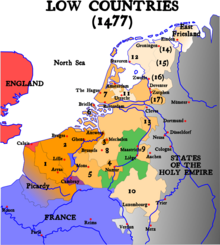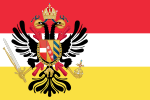Habsburg Netherlands
Habsburg Netherlands | |||||||||||||||
|---|---|---|---|---|---|---|---|---|---|---|---|---|---|---|---|
| 1482–1797 | |||||||||||||||

| |||||||||||||||
| Status | French | ||||||||||||||
| Religion |
| ||||||||||||||
Government | Monarchy | ||||||||||||||
| Historical era | Early modern period | ||||||||||||||
• Inherited by House of Habsburg | 1482 | ||||||||||||||
• Incorporated into Burgundian Circle | 1512 | ||||||||||||||
| 1549 | |||||||||||||||
• Inherited by Habsburg Spain | 1556 | ||||||||||||||
| 30 January 1648 | |||||||||||||||
| 7 March 1714 | |||||||||||||||
| 18 September 1794 | |||||||||||||||
| 17 October 1797 | |||||||||||||||
| ISO 3166 code | NL | ||||||||||||||
| |||||||||||||||
Habsburg Netherlands
Becoming known as the
Geography
The Habsburg Netherlands was a geo-political entity covering the whole of the Low Countries (i.e. the present-day Netherlands, Belgium, Luxembourg, and most of the modern French départements of Nord and Pas-de-Calais) from 1482 to 1581. The northern Low Countries began growing from 1200 CE, with the drainage and flood control of land, which could then be cultivated. The population rose and the region of Holland became important. Before that, the development of large cities was in the south, with Ghent, Bruges, Antwerp, Brussels, and Leuven, all of which were larger than any settlement in the north. Rivers in the Low Countries run east–west and were a political and strategic barrier to influence southern influence on the north, forming two separate political areas.[6]

Already under the Holy Roman Empire rule of the Burgundian duke
Philip's son Duke
History

Upon the death of Mary of Burgundy in 1482, her substantial possessions including the
Philip's son
Following a series of abdications between 1555 and 1556, Charles V divided the House of Habsburg into an Austrian-German and a Spanish branch. His brother Ferdinand I became suo jure monarch in Austria, Bohemia and Hungary, as well as the new Holy Roman Emperor. Philip II of Spain, Charles' son, inherited the Seventeen Provinces and incorporated them into the Spanish Crown (which included also south Italy and the American possessions). King Philip II of Spain became infamous for his despotism, and Catholic persecutions sparked the Dutch Revolt and the subsequent Eighty Years' War. The Spanish hold on the northern provinces was more and more tenuous. In 1579 the northern provinces established the Protestant Union of Utrecht, in which they declared themselves independent as the Seven United Provinces by the 1581 Act of Abjuration.
After the secession of 1581, the southern provinces, called "'t Hof van Brabant" (of Flandria, Artois, the Tournaisis, Cambrai, Luxembourg, Limburg, Hainaut, Namur, Mechelen, Brabant, and Upper Guelders) remained with the House of Habsburg until the French Revolutionary Wars. After the extinction of the Spanish Habsburg line in 1700 with the death of the childless Charles II and the War of the Spanish Succession (1700-14), the southern provinces were also known as the Austrian Netherlands from 1715 onwards.
Rulers
- 1482–1506 Philip I of Castile as Duke of Burgundy, Maximilian I, his father, as regent (1482–1493), Margaret of York, his stepgrandmother, governess (1489–1493)
- 1506–1556 Charles V as Duke of Burgundy, as Holy Roman Emperor from 1519.
- 1556–1581 Philip II as King of Spain
The provinces were ruled on their behalf by a
- 1489–1493 Margaret of York, dowager Duchess of Burgundy
- 1506–1507 William de Croÿ, Marquis d'Aerschot
- 1507–1530 Margaret of Austria, Duchess of Savoy
- 1531–1555 Mary of Hungary
- 1555–1559 Emmanuel Philibert, Duke of Savoy
- 1559–1567 Margaret of Parma
- 1567–1573 Fernando Álvarez de Toledo, 3rd Duke of Alba
- 1573–1576 Luis de Requesens y Zúñiga
- 1576–1578 John of Austria
- 1578–1592 Alexander Farnese, Duke of Parma. In 1578, the Dutch insurgents appointed Archduke Matthias of Austria governor, though he could not prevail and resigned before the 1581 Act of Abjuration.
- 1685–1692 Francisco Antonio de Agurto Salcedo Medrano Zúñiga
Flag
During the Spanish period it is assumed that the flag was the Cross of Burgundy. After a period of turmoil with the Eighty Years' War, by 1713 the Southern Netherlands were separated from Spain and attached to Austria, assuming a flag consisting of three equal horizontal bands displaying the colours of : red, white and gold. A small cross of Burgundy was present, which in 1781 was covered by a black double-headed eagle.
See also
References
- ^ (Dutch: Habsburgse Nederlanden; French: Pays-Bas des Habsbourg), in Latin referred to as Belgica
- ISBN 9004138501.
- ^ "How Brussels became the capital of Europe 500 years ago". The Brussels Times. 2017-04-21. Retrieved 2020-03-01.
- ISBN 978-1-4766-0889-1.
- ISBN 9781317755005.
- ^ Israel, Jonathan. The Dutch Republic, pp. 11-12




